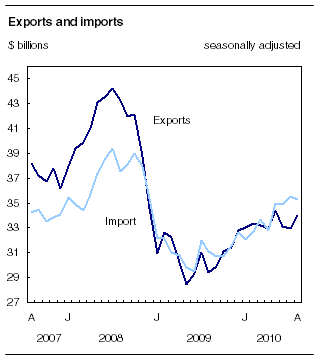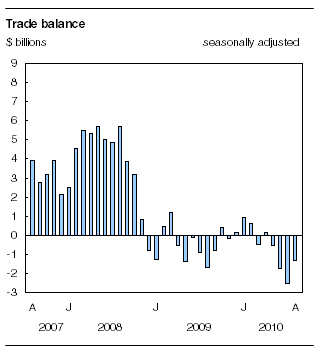Common menu bar links
Canadian international merchandise trade
Archived Content
Information identified as archived is provided for reference, research or recordkeeping purposes. It is not subject to the Government of Canada Web Standards and has not been altered or updated since it was archived. Please "contact us" to request a format other than those available.
Related subjects
Canada's merchandise exports rose 3.1% to $34.0 billion in August, following two months of declines. Industrial goods and materials and other consumer goods accounted for over three-quarters of the growth.

Export volumes rose 2.9% and have been on an upward trend since May 2009.
After a gain in July, imports declined 0.5% to $35.3 billion, as prices fell 0.8%. Import volumes, which have been on an upward trend since March 2009, increased 0.3% in August.
The main sectors behind the decline in imports were automotive products and industrial goods and materials. These declines were tempered by increases in imports of other consumer goods and energy products.
Canada's trade deficit with the world narrowed to $1.3 billion in August from $2.5 billion in July.
Exports to the United States rose by 2.7%, led by higher exports of passenger autos, while imports fell by 3.3%. Consequently, Canada's trade surplus with the United States increased to $2.9 billion in August from $1.5 billion in July. This was the first increase in Canada's trade surplus with the United States since December 2009.
Note to readers
Merchandise trade is one component of Canada's international balance of payments, which also includes trade in services, investment income, current transfers as well as capital and financial flows.
International merchandise trade data by country are available on both a balance of payments and a customs basis for the United States, Japan and the United Kingdom. Trade data for all other individual countries are available on a customs basis only. Balance of payments data are derived from customs data by making adjustments for characteristics such as valuation, coverage, timing and residency. These adjustments are made to conform to the concepts and definitions of the Canadian System of National Accounts.
Data in this release are on a balance of payments basis, seasonally adjusted in current dollars. Constant dollars are calculated using the Laspeyres volume formula.
Revisions
In general, merchandise trade data are revised on an ongoing basis for each month of the current year. Current year revisions are reflected in both the customs and balance of payments based data. Revisions to customs based data for the previous year are released on a quarterly basis. Revisions to balance of payments based data for the three previous years are released annually in June.
Factors influencing revisions include late receipt of import and export documentation, incorrect information on customs forms, replacement of estimates with actual figures, changes in classification of merchandise based on more current information, and changes to seasonal adjustment factors.
Revised data are available in the appropriate CANSIM tables.
Exports to countries other than the United States grew 4.2%, while imports rose 4.5%. Both gains were largely the result of increases in trade with the European Union. Canada's trade deficit with countries other than the United States rose to $4.3 billion in August from $4.1 billion in July.

Widespread increases in exports
All export sectors grew in August with the exception of automotive products. Exports of industrial goods and materials grew 5.8% to $8.0 billion, a second consecutive monthly increase. The growth in the sector was largely the result of a 4.4% increase in prices, mostly reflecting higher prices for gold and metal ores. Precious metals increased 21.9%, followed by copper ores and nickel ores. Fertilizers and fertilizer materials also recorded solid gains.
Exports of other consumer goods rose 26.8% to $1.6 billion, following a 9.2% decline in July. The increase was the result of a 25.9% gain in volumes. Medicinal and pharmaceutical products in dosage largely accounted for the advance in the sector.
In the machinery and equipment sector, exports increased 2.2% to $6.5 billion, the highest level since July 2009. The increase reflected a 4.8% rise in volumes, as prices fell 2.4%. Prices of machinery and equipment have been on a downward trend since March 2009. Within the sector, the main contributors to the rise in exports were aircrafts, engines and parts, telecommunication equipment and industrial machinery.
Exports of automotive products totalled $5.2 billion in August, virtually unchanged from July. A strong increase in exports of passenger autos was offset by declines in exports of motor vehicle parts and trucks and other motor vehicles. Export volumes rose 1.3%, while prices fell.
Automotive products lead the decline in imports
Imports of automotive products fell 6.5% to $5.8 billion, as volumes decreased 6.1%. Imports of passenger autos, which declined 12.9%, represented over two-thirds of the decrease in the sector. Lower imports from overseas mainly accounted for the decline in imports of passenger autos. Imports of trucks and motor vehicle parts also fell in August.
Imports of industrial goods and materials decreased 3.3% to $7.1 billion, led by a decline in imports of metal in ores, namely nickel ores and zinc ores. Precious metals also contributed to the decrease. Higher imports of other chemicals, such as fertilizers, moderated the decline. Prices of industrial goods and materials fell 3.4% in August.
Imports of other consumer goods rose 2.4% to $5.0 billion as a result of higher volumes. Increases throughout the sector were led by higher imports of miscellaneous end products such as articles for the Christmas season. Imports of apparel and accessories also grew.
Imports of energy products rose 2.5% in August to $3.4 billion, on the strength of coal and other related products, notably natural gas. Imports of crude petroleum as well as petroleum and coal products decreased after solid gains in July. Volumes of energy products rose 8.0%, while prices fell 5.1%.
Available on CANSIM: tables 228-0001 to 228-0003, 228-0033, 228-0034, 228-0041 to 228-0043 and 228-0047 to 228-0057.
The merchandise imports and exports data in the following tables are presented in dollar values.
Tables 228-0001 to 228-0003: Customs and balance of payments basis, by major groups and principal trading areas for all countries; monthly, quarterly, and annual.
Table 228-0033: Imports, customs-based, by province of clearance; monthly.
Table 228-0034: Domestic exports, customs-based, by province of origin; monthly.
Tables 228-0041 to 228-0043: Customs and balance of payments basis, by sector and sub-sector, for all countries; monthly, quarterly, and annual.
The merchandise imports and exports data in the following tables are indexes (2002=100).
Tables 228-0047 to 228-0049: Balance of payments and customs-based price and volume indexes for all countries; monthly, quarterly, and annual.
Tables 228-0050 to 228-0052: Customs-based price indexes, Canada and United States trade, and Standard International Trade Classification (SITC revision 3) price indexes for all countries and the United States; monthly, quarterly, and annual.
Tables 228-0053 to 228-0055: Price and volume indexes, customs and balance of payments basis, by sector and sub-sector, for all countries; monthly, quarterly, and annual.
Tables 228-0056 and 228-0057: Balance of payments basis, by sector, seasonally adjusted, Fisher formula, chained 2002 dollars, for all countries; monthly and quarterly.
Definitions, data sources and methods: survey numbers, including related surveys, 2201, 2202 and 2203.
These data are available in the Canadian international merchandise trade database.
The August 2010 issue of Canadian International Merchandise Trade, Vol. 64, no. 8 (65-001-X, free), is now available from the Key resource module of our website under Publications.
Current account data (which incorporate merchandise trade statistics, service transactions, investment income and transfers) are available quarterly in Canada's Balance of International Payments (67-001-X, free).
Data on Canadian international merchandise trade for September will be released on November 10.
For more information, or to order data, contact Client Services (toll-free 1-800-294-5583; 613-951-9647; trade@statcan.gc.ca). To enquire about the concepts, methods or data quality of this release, contact Mychèle Gagnon (613-951-0994), International Trade Division.
Table 1
| August 2009 | July 2010r | August 2010 | July to August 2010 | August 2009 to August 2010 | |
|---|---|---|---|---|---|
| Seasonally adjusted, $ current | |||||
| $ millions | % change | ||||
| Principal trading areas | |||||
| Exports | |||||
| United States | 22,190 | 24,489 | 25,149 | 2.7 | 13.3 |
| Japan | 641 | 841 | 828 | -1.5 | 29.2 |
| European Union1 | 2,095 | 2,964 | 3,261 | 10.0 | 55.7 |
| Other OECD countries2 | 1,316 | 1,290 | 1,340 | 3.9 | 1.8 |
| All other countries | 3,177 | 3,382 | 3,402 | 0.6 | 7.1 |
| Total | 29,419 | 32,967 | 33,980 | 3.1 | 15.5 |
| Imports | |||||
| United States | 19,764 | 22,958 | 22,201 | -3.3 | 12.3 |
| Japan | 809 | 803 | 786 | -2.1 | -2.8 |
| European Union1 | 2,892 | 3,183 | 3,648 | 14.6 | 26.1 |
| Other OECD countries2 | 2,649 | 2,370 | 2,307 | -2.7 | -12.9 |
| All other countries | 4,984 | 6,199 | 6,384 | 3.0 | 28.1 |
| Total | 31,099 | 35,512 | 35,325 | -0.5 | 13.6 |
| Balance | |||||
| United States | 2,426 | 1,531 | 2,948 | ... | ... |
| Japan | -168 | 38 | 42 | ... | ... |
| European Union1 | -797 | -219 | -387 | ... | ... |
| Other OECD countries2 | -1,333 | -1,080 | -967 | ... | ... |
| All other countries | -1,807 | -2,817 | -2,982 | ... | ... |
| Total | -1,680 | -2,545 | -1,345 | ... | ... |
Table 2
| August 2009 | July 2010r | August 2010 | July to August 2010 | August 2009 to August 2010 | |
|---|---|---|---|---|---|
| Seasonally adjusted, $ current | |||||
| $ millions | % change | ||||
| Exports | |||||
| Agricultural and fishing products | 2,761 | 3,011 | 3,013 | 0.1 | 9.1 |
| Energy products | 6,567 | 7,026 | 7,040 | 0.2 | 7.2 |
| Forestry products | 1,536 | 1,794 | 1,819 | 1.4 | 18.4 |
| Industrial goods and materials | 6,235 | 7,576 | 8,016 | 5.8 | 28.6 |
| Machinery and equipment | 6,144 | 6,366 | 6,508 | 2.2 | 5.9 |
| Automotive products | 3,834 | 5,160 | 5,158 | 0.0 | 34.5 |
| Other consumer goods | 1,413 | 1,275 | 1,617 | 26.8 | 14.4 |
| Special transactions trade1 | 513 | 293 | 347 | 18.4 | -32.4 |
| Other balance of payments adjustments | 416 | 465 | 463 | -0.4 | 11.3 |
| Total | 29,419 | 32,967 | 33,980 | 3.1 | 15.5 |
| Imports | |||||
| Agricultural and fishing products | 2,423 | 2,460 | 2,514 | 2.2 | 3.8 |
| Energy products | 3,040 | 3,319 | 3,402 | 2.5 | 11.9 |
| Forestry products | 194 | 234 | 223 | -4.7 | 14.9 |
| Industrial goods and materials | 5,845 | 7,350 | 7,111 | -3.3 | 21.7 |
| Machinery and equipment | 8,676 | 9,863 | 9,894 | 0.3 | 14.0 |
| Automotive products | 5,250 | 6,241 | 5,836 | -6.5 | 11.2 |
| Other consumer goods | 4,637 | 4,861 | 4,979 | 2.4 | 7.4 |
| Special transactions trade1 | 388 | 446 | 639 | 43.3 | 64.7 |
| Other balance of payments adjustments | 646 | 740 | 727 | -1.8 | 12.5 |
| Total | 31,099 | 35,512 | 35,325 | -0.5 | 13.6 |

